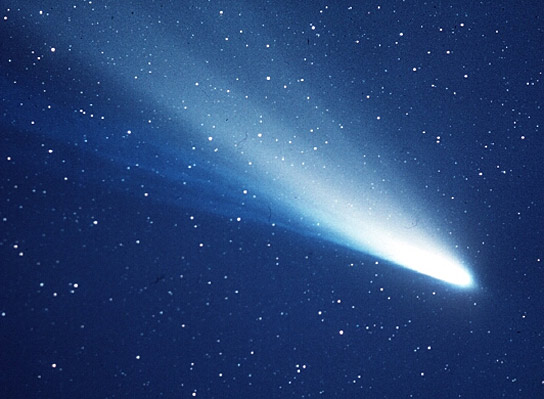Rabbi Yehoshua (Joshua) Ben Hananiah (c. 35&endash;117 CE) was a leading Jewish scholar and a member of the Academy in Yavneh, which was very active after the destruction of Jerusalem and the Second Temple by the Romans, in 70 CE. He is one of the most frequently mentioned sages in the Mishnah -- the first written redaction of the Jewish oral traditions. But what does a Jewish Rabbi from the first century have to do with Halley's Comet? To remind ourselves, Halley's Comet (Figure 1) was the first comet discovered to be periodic. Incidentally, it was also the first comet to be photographed from a relatively close distance by spacecraft. In 1705, astronomer Edmond Halley (1656–1742) used Newton's laws of gravity and motion to calculate that a comet seen in 1682 was, in fact, the same comet that had previously been seen in 1531 and 1607. Halley therefore suggested that the comet had a period of about 76 years, and predicted its return in 1758 (the period in fact varies somewhat due to the gravitational effects of the giant planets).

Figure 1. An image of Halley's Comet taken in 1986. Credit: NASA.
Earlier passages of Halley's Comet were later calculated and meticulously compared with historical records of previous sightings of comets. Chinese astronomers recorded the earliest confirmed appearance, in 240 BCE, but some speculate that a comet observed by astronomers in ancient Greece, in 467 BCE, may also have been Halley's Comet.
Rabbi Yehoshua Ben Hanania enters this astronomical story through an intriguing anecdote in the tractate Horayoth ("rulings") in the Talmud -- the central Rabbinic text. The passage reads as follows:
Rabbi Gamliel and Rabbi Yehoshua went together on a voyage at sea. Rabbi Gamliel carried a supply of bread, Rabbi Yehoshua carried a similar amount of bread and in addition a reserve of flour. At sea, they used up the entire supply of bread and had to utilize Rabbi Yehoshua's flour reserve. Rabbi Gamliel then asked Rabbi Yehoshua: "Did you know that this trip would be longer than usual, when you decided to carry this flour reserve?" Rabbi Yehoshua answered: "There is a star that appears every 70 years and induces navigation errors. I thought it might appear and cause us to go astray." Rabbi Gamliel then exclaimed: "You are so knowledgeable and you nevertheless have to travel to make a living?" Rabbi Yehoshua then answered bitterly: "How come you are so surprised? Don't you know that two of your own students Rabbi Eliezer Hisma and Rabbi Yehohanan Ben Gudgada who are so smart that they can tell you how many drops there are in the ocean, have neither bread to eat nor clothes to wear?"
This surprising story is generally interpreted as evidence that Mishnaic scholars knew about the periodic return of Halley's Comet. If true, then they might have obtained the astronomical records from the preceding Great Knesset scholars (active before 300 BCE), who had probably learned about it during the Babylonian exile (in the 6 century BCE). The fact is that the visits of Halley's Comet in both 164 BCE and 87 BCE were recorded on Babylonian tablets.
Not everyone agrees with this interpretation of the Talmudic anecdote. Some have argued that at the only time during Rabbi Yehoshua's life that Halley's comet appeared, on January 25, 66 CE, Rabbi Gamliel was only in his twenties, and therefore he could not have had students. This objection, however, is not particularly convincing, since Rabbi Gamliel was the recognized hereditary Patriarch (his father was a key figure in the war against the Romans and his grandfather a leading scholar). Consequently, he may have had students assigned to him early on.
Astronomer Philippe Veron came up in 1982 with another possible identification of Rabbi Yehoshua's star. He noted that the variable star Mira Ceti has its brightest maxima separated by approximately 60 years, and suggested that this may have been the "new" star noted by many generations of scholars (Figure 2 illustrates the appearance of Mira Ceti in 1677).

Figure 2. An engraving from 1677 showing the appearance of Mira Ceti (labeled "der neue Wunder-Stern"; the new Wonder-Star). From Veron, P. 1982, l'Astronomie, 96, 351.
Irrespective of the precise identification, however, the ancient passage testifies to the fact that some of the Mishnaic and Talmudic scholars were also curious astronomers!